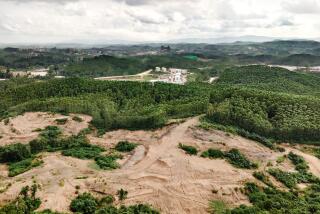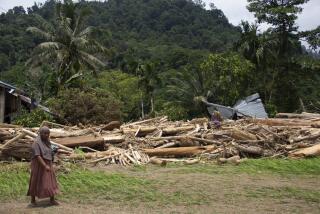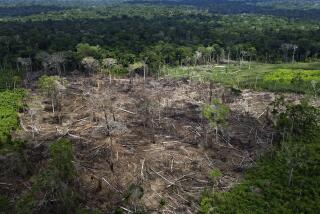Biofuel boom backfiring
TANJUNG PUTING NATIONAL PARK, INDONESIA — In the rush to feed the world’s growing appetite for climate-friendly fuel and cooking oil that doesn’t clog arteries, the Bornean orangutan could get plowed over.
Several plantation owners are eyeing Tanjung Puting park, a sanctuary for 6,000 of the endangered animals. It is the world’s second-largest population of a primate that experts warn could be extinct in less than two decades if a massive assault on its forest habitat is not stopped.
The orangutans’ biggest enemy, the United Nations says, is no longer poachers or loggers. It’s the palm oil industry.
On the receding borders of this 1,600-square-mile lush reserve, a road paved with good intentions runs smack into a swamp of alleged corruption and government bungling. It’s one of the mounting costs few bargained for in the global craze to “go green.”
The park clings to the southern tip of the island of Borneo, which is shared by Indonesia and Malaysia, the top producers of palm oil. Exporters market it as an alternative to both petroleum and cooking oils containing trans fats.
“That’s only a slogan, you know,” said Ichlas Al Zaqie, the local project manager for Los Angeles-based Orangutan Foundation International. “They change the forest, and say it’s for energy sustainability, but they’re killing other creatures.”
Indonesia is losing lowland forest faster than any other major forested country. At the rate its trees are being felled to plant oil palms, poach high-grade timber and clear land for farming, 98% of Indonesia’s forest may be lost by 2022, the United Nations Environment Program says.
“If the immediate crisis in securing the future survival of the orangutan and the protection of national parks is not resolved, very few wild orangutans will be left within two decades,” UNEP concluded in a report last year. “The rate and extent of illegal logging in national parks may, if unchallenged, endanger the entire concept of protected areas worldwide.”
In July, loggers finished buzz-sawing and bulldozing a 40,000-acre swath in a northeastern corner of the park, where at least 561 orangutan lived, to clear ground for oil palm plants, Zaqie said.
The government isn’t much help, say environmental activists, who accuse corrupt officials, military and police officers of siding with timber poachers, illegal miners and others threatening the forests.
Activists bemoan a territorial dispute between local officials and the provincial and national governments.
“The problem now is even the central government can’t really say where the exact border of the national park is,” said Yeppie Kustiwae, who handles the issue of forest conversion for the World Wide Fund for Nature in Indonesia.
Zaqie says palm oil companies are determined to take as much as 5 million acres of orangutan forest habitat in Tanjung Puting and the larger Sebangau National Park, where Borneo’s largest population of orangutans lives.
Tanjung Puting, a tropical Eden still revealing its secrets, shelters nine primate species, including rare proboscis monkeys, whose pendulous schnozzes can be 7 inches long.
Zaqie says he first saw bulldozers knocking down trees for the northeastern palm oil plantation five years ago. He was certain the loggers were on land included in the park in a 1996 government decree.
He tried without success to stop the bulldozer operators. So Zaqie went to a manager, who confirmed that the forest was being converted into a plantation by an Indonesian company called Wanasawit Subur Lestari. A spokesman for its parent company, BEST Plantation Group, denied encroaching on the park.
“We are working based on a permit issued by the government,” said Wahyu Bimadhrata, BEST’s legal manager. “We don’t work inside the national park.”
Mounting pressures on the forest are easiest to see in the money made by palm oil plantations. In 1990, Indonesia earned $204 million from palm oil exports; the value exploded to more than $7.8 billion in 2007.
Palm oil exports started growing sharply five years ago after the European Union declared a mandatory quota to replace gasoline and diesel from crude with biofuels. Last year, it raised the biofuel target to 10% of transportation fuels by 2020, driving the price of palm oil higher and ratcheting up the threat to rain forests.
The EU has maintained the policy even though a report in April by European Environment Agency scientists called it an “overambitious” experiment “whose unintended effects are difficult to predict and difficult to control.”
Instead of reducing greenhouse gas emissions, producing palm oil on what was once peat swamp forests may be boosting the amount of carbon dioxide in the atmosphere. Leveling the jungle not only destroys trees that absorb carbon dioxide, it also releases millions of tons of carbon dioxide stored in Borneo’s peat for thousands of years. Fires set to clear trees and stumps add to the problem.
As companies lobby to clear more rain forest, other Indonesians are laboring to restore habitat for orangutans and rehabilitate those who lost their jungle homes or were rescued from poachers.
A decade ago, raging fires burned millions of acres of Borneo’s forest. The Borneo Orangutan Survival Foundation bought 4,500 acres that farmers had abandoned to grassland at Samboja Lestari, on the island’s eastern side.
“People thought that in one or two years, we would give up,” said Ishak Yassir, the foundation’s regional program manager. “We proved them wrong.”
His Indonesian staff cares for 224 orangutans; each day, teachers take their wide-eyed pupils to forest school. They teach them the basics, such as tree climbing; the proper way to eat dirt to get at insects, seeds and other nutrients; and avoiding snakes.
Once they graduate, they join the list of orangutans ready to leave rehab.
Yassir’s staff has cleared more than 50 young adults for release over the last six years. But the orangutans’ rescuers can’t find enough safe forest for the apes to go home to.
--
Special correspondent Dinda Jouhana in Jakarta, Indonesia, contributed to this report.
--
On latimes.com
Forest and friends
More photos from the park at latimes.com/world
More to Read
Sign up for Essential California
The most important California stories and recommendations in your inbox every morning.
You may occasionally receive promotional content from the Los Angeles Times.










